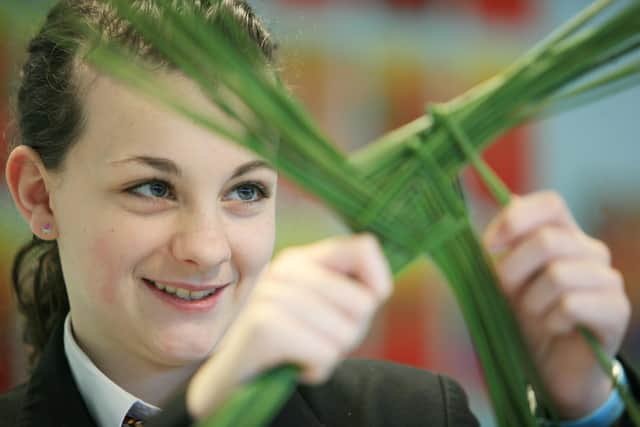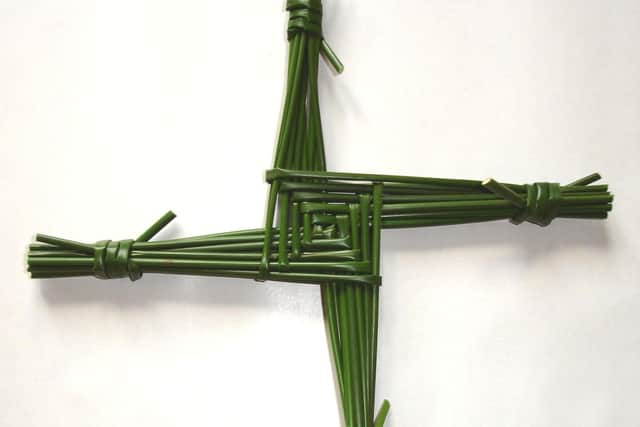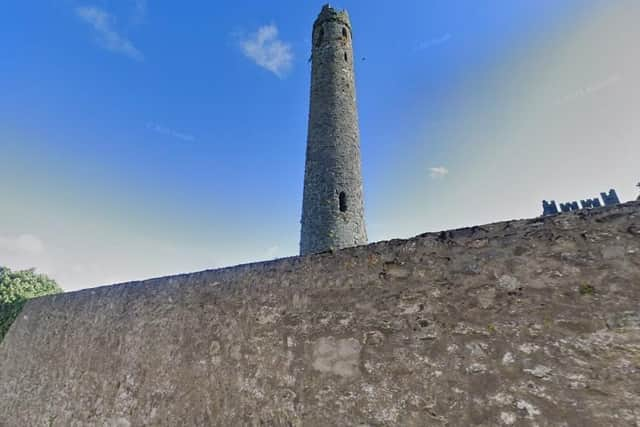Crosses fashioned, poundies eaten and rags left out as St. Brigid tradition is kept alive
and live on Freeview channel 276
St. Brigid’s Day (Lá Fhéile Bríde) commemorates St. Brigid of Kildare, one of the three main patrons of Ireland.
She was born around 451-2 at Faughart, Louth, and is most famous for erecting her monastery at Kildare – ‘the church of the oak’.
Advertisement
Hide AdAdvertisement
Hide AdThe saint has been associated with the goddess Brigid, a member of the Tuatha Dé Danann, who appears in the Irish mythological cycle.


February 1, her feast, coincides with Imbolc (i mbolg – ‘in the belly’ – a reference the coming of spring), which is one of the four main seasonal festivals that mark the turning of the Irish year alongside Samhain (Halloween], Beltaine (the coming of summer in May) and Lughnasa (the August harvest festival).
In the late 1930s the Irish Folklore Commission gathered traditions associated with St. Brigid that were collected by school pupils from parents and grandparents.
Bridget McColgan, from Iskaheen, a pupil at Carnamoyle, told of a tradition recognisable today.


Advertisement
Hide AdAdvertisement
Hide Ad“There are crosses made on St. Brigid's Day. When making crosses you twist one rush round another. Rushes are what you make them with. They can be made any size. They are made by the family. There is a cross placed in every room in the house and one in every outhouse.”
Sarah Grant, also from Iskaheen, gave the following:
“The rushes are cut before sunset. Then they are left behind the house. When it gets dark the poundies are made. Then the man of the house goes out for the rushes, then everybody kneels down and says their prayers. When the prayers are said the crosses are made then.”
Mary McCullough, from Dunree, a pupil at St Egney's, got this from her mother who was aged 40:


“Before you would make the crosses from the rushes you would spread the rushes on the floor, and you would place a pot of poundies on the top of the rushes.
Advertisement
Hide AdAdvertisement
Hide Ad"Then, when you had the poundies bruised for dinner, you gathered up the rushes in little bundles for making the crosses. When the crosses were made they were sprinkled with holy water, and one was put up in what ever houses you had.
“We make St. Brigid’s cross in honour of her. It is made with straw, and sometimes rushes. There are two kind of crosses made in honour of her. The large cross is made with two sticks crossed, and straw or rushes are put round and round these sticks till the cross is shaped.
“The small cross is made without sticks, and there are equal sized arms made in it, and it is made much in the same way as the long one.”
Philomena McGrath was a pupil at Grianán Ailigh who lived near Burt.
Advertisement
Hide AdAdvertisement
Hide AdShe stated: “On St. Brigid's night some people leave a cloth outside before going to bed.”
Hamilton Ferguson, from Fahan, got the following from a Mr. Ferguson, a 54-year-old farmer, who told of a dark superstition.
“On St Patrick's Day and St Brigid's day they kept a cross made out of straw hung up on the kitchen wall. Anyone in the family could make it. If the cross fell down it was a sign of a death in the house.”
Arthur Peoples, a pupil from Castlecary, gave the following intelligence:
Advertisement
Hide AdAdvertisement
Hide Ad“A tradition still carried on in this locality by most of the people is by gathering a bundle of rushes the day before St. Brigid's Day. The man of the house cuts rushes and goes round the house three times, each time he comes to the door the same prayer is said.
"The rushes are placed underneath the tables, and the people are all invited to take of the meal. The rushes are woven in crosses. A cross is put in every house, and that is to keep away ill luck, and to bring good luck for the coming year.
“The crosses are blessed by St. Brigid that night. A garment is taken from each member of the house and left outside so that St. Brigid may find warm wraps on her way.”
Eithne Nic an tSaoir, from Ray, was told of similar rituals by Peadair Uí Ghallochbhair, a 73-year-old farmer.
Advertisement
Hide AdAdvertisement
Hide Ad“Someone goes out for the rushes, kneels on them at the doorstep and says three times, ‘Go on your knees, open your eyes and let in St. Brigid.’ Those who are inside answer three times, ‘She's welcome’. The rushes are then taken inside and crosses are made, and are put up in the different places of the house, and in all the outhouses, to save everyone from sickness, fire and lightning.
"There are different causes as to why these crosses are made, and it is said that one time there was a great plague in Ireland, and St. Brigid made crosses of rushes, straw and rags and put them up in her convent and the plague never came near the convent.”
John C. Mullen, from Faugher, got the following from G. Mullen, aged 76.
“You leave the rushes on the door step until night and then somebody goes out for them. The person that goes out knocks and says. "Gabhaigidh bhur nglúna agus fosgailí bhur súile agus leigigidh isteach Bhrígid bhig bhéannacht". The person inside says "Sé do bheatha a mná uaisle...If you leave a rag outside that night and take it in in the morning it will cure a headache, or if you sleep that night with a rush tied round your head it will also cure a headache.
Advertisement
Hide AdAdvertisement
Hide AdAnd this was contributed by Seán Ó Seanacháin, a teacher at St. Johnston: “St. Brigid's Day is observed by getting candles blessed in the Chapel. Also by getting crosses blessed and later these crosses are hung up in all the rooms of the houses and in all the offices.”